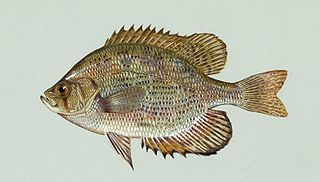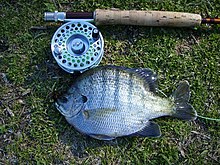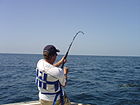
Centrarchidae, better known as sunfishes, is a family of freshwater ray-finned fish belonging to the order Perciformes, native only to North America. There are eight universally included genera within the centrarchid family: Lepomis, Micropterus, Pomoxis (crappies), Enneacanthus, Centrarchus, Archoplites, Ambloplites, and Acantharchus. A genetic study in 2012 suggests that the highly distinct pygmy sunfishes of the genus Elassoma are also centrarchids.

The Tippecanoe River is a gentle, 182-mile-long (293 km) river in the Central Corn Belt Plains ecoregion in northern Indiana. It flows from Crooked Lake in Noble County to the Wabash River near what is now Battle Ground, about 12 miles (19 km) northeast of Lafayette. The name "Tippecanoe" was derived from a Miami-Illinois word for buffalo fish, reconstructed as */kiteepihkwana/ or as kiteepihkwana siipiiwi.

Crappies are two species of North American freshwater fish of the genus Pomoxis in the family Centrarchidae (sunfishes). Both species of crappies are popular game fish among recreational anglers.

The bluegill ,(which has three relatively unknown subspecies,the Florida Bluegill, Hand Painted Bluegill and Northern Bluegill), is a species of North American freshwater fish, native to and commonly found in streams, rivers, lakes, ponds and wetlands east of the Rocky Mountains. It is the type species of the genus Lepomis, from the family Centrarchidae in the order Perciformes.

Lepomis or true sunfish is a genus of North American freshwater fish from the family Centrarchidae in the order Perciformes. The generic name Lepomis derives from the Greek λεπίς ("scale") and πῶμα. The genus' most recognizable type species is perhaps the bluegill.

The redear sunfish, also known as the shellcracker, Georgia bream, cherry gill, chinquapin, improved bream, rouge ear sunfish and sun perch) is a freshwater fish in the family Centrarchidae and is native to the southeastern United States. Since it is a popular sport fish, it has been introduced to bodies of water all over North America. It is known for its diet of mollusks and snails.
Lake Hook, sometimes referred to as Hook Lake, is a 330 square acre lake in McLeod County, in the U.S. state of Minnesota, that is a popular fishing destination. The lake is approximately 18 feet at its deepest point with an average depth of 8 feet and a shoreline spanning 4 miles.

A plastic worm or trout worm is a soft-bodied fishing lure made of elastomer polymer material, generally simulating an earthworm. Plastic worms are typically impaled onto a hook, and can carry a variety of shapes, colors and sizes, awith some are even scented to simulate live bait.
Bayles Lake is a freshwater reservoir located in west Loda, Illinois in Iroquois County, 13.6 miles from Onarga and separated by a road from Lake Iroquois, Illinois.

A game fish is any species of fish pursued for sport by recreationalists (anglers). The capture of game fish is usually tightly regulated. In comparison, nongame fish are all fish not considered game fish. Game fish may be eaten after being caught, though increasingly anglers are practicing catch-and-release tactics to improve fish populations.
Fishing in Colorado has brought in a large amount of revenue for the state. In 2019 Colorado Parks and Wildlife estimated outdoor recreation contributed roughly 62 billion dollars to the state economy. Fishing was reported to be the 5th most popular outdoor activity and 110, 511 fishing and hunting combination licenses were sold. Ice fishing makes up part of this total fishing revenue and is a common annual sport for Colorado residents and out-of-state visitors. There is no legal definition of ice fishing season. Rather, people begin to ice fish once the lakes freeze over with thick enough ice. Colorado Parks and Wildlife also recommend that people always ice-fish with another person. Typically, this starts in December and ends in April for Colorado. Lakes size, depth, elevation, and seasonal weather can cause variance to the season. Once the lakes freeze over with thick enough ice, anglers go out onto the ice, drill holes through the ice, and fish for a variety of species.












